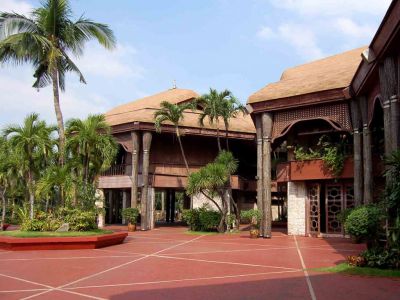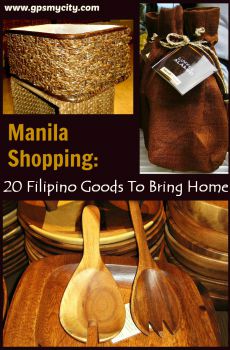Coconut Palace, Manila
The Tahanang Pilipino (Filipino home), otherwise known as the Coconut Palace, is located at the heart of the Cultural Center of the Philippines complex in Manila. The Palace was built in 1978 by Francisco Mariosa for Pope John Paul II’s visit in 1981. Ironically, the Pope did not step into the Palace since he considered it to be flamboyant for the poverty-stricken country. The Palace initially served as the Presidential Guest House of Ferdinand Marcos, the former Philippine dictator, and was commissioned by his wife Imelda Marcos in 1981. Today, this Palace serves not only as an official residence of Vice President but also as a venue for romantic wedding receptions.
The Palace is famous for its design and extraordinary features. 70% of this octagon shaped structure is made of coconut lumber along with coconut shells and a variety of Philippine hardwood. The roof is shaped like a hat, or the traditional salakot. The 101-coconut chandelier and the dinning table with 40,000 inlaid coconut shell pieces are the highlights of this palace. Named after various provinces of the country are the 7 palatial rooms, namely: the Zamboanga, the Pampanga, (made of Jusi fibers and displays statues of Kampampangan style of art), the Marawi (purple and green colored room representing Muslim Mindanao), the Bicol, the Mountain Province room (a room full of artifacts traditional to Ifugao or Cordillera tribe), the Iloilo, and the Pangasinan (made of Pina fibers) rooms. The Palace also has a colossal swimming pool, a beautiful butterfly garden and an orchidarium. During its history, the Palace has accommodated a number of honorable guests including George Hamilton, Brooke Shields and Muammar al-Gaddafi.
The Palace is famous for its design and extraordinary features. 70% of this octagon shaped structure is made of coconut lumber along with coconut shells and a variety of Philippine hardwood. The roof is shaped like a hat, or the traditional salakot. The 101-coconut chandelier and the dinning table with 40,000 inlaid coconut shell pieces are the highlights of this palace. Named after various provinces of the country are the 7 palatial rooms, namely: the Zamboanga, the Pampanga, (made of Jusi fibers and displays statues of Kampampangan style of art), the Marawi (purple and green colored room representing Muslim Mindanao), the Bicol, the Mountain Province room (a room full of artifacts traditional to Ifugao or Cordillera tribe), the Iloilo, and the Pangasinan (made of Pina fibers) rooms. The Palace also has a colossal swimming pool, a beautiful butterfly garden and an orchidarium. During its history, the Palace has accommodated a number of honorable guests including George Hamilton, Brooke Shields and Muammar al-Gaddafi.
Want to visit this sight? Check out these Self-Guided Walking Tours in Manila. Alternatively, you can download the mobile app "GPSmyCity: Walks in 1K+ Cities" from Apple App Store or Google Play Store. The app turns your mobile device to a personal tour guide and it works offline, so no data plan is needed when traveling abroad.
Coconut Palace on Map
Sight Name: Coconut Palace
Sight Location: Manila, Philippines (See walking tours in Manila)
Sight Type: Attraction/Landmark
Sight Location: Manila, Philippines (See walking tours in Manila)
Sight Type: Attraction/Landmark
Walking Tours in Manila, Philippines
Create Your Own Walk in Manila
Creating your own self-guided walk in Manila is easy and fun. Choose the city attractions that you want to see and a walk route map will be created just for you. You can even set your hotel as the start point of the walk.
Traditional Markets
Traditional markets showcase a unique aspect of life in any city. The ones featured in this walk offer a glance into the authentic life and habits of Manila’s people and play a vital role in the Philippines' capital's economic and cultural landscape. Traditionally, local markets sell a broader range of products than regular shops can provide: from veggies and fruits to dried fish and... view more
Tour Duration: 1 Hour(s)
Travel Distance: 3.0 Km or 1.9 Miles
Tour Duration: 1 Hour(s)
Travel Distance: 3.0 Km or 1.9 Miles
Manila Introduction Walking Tour
The capital of the Philippines, Manila was officially founded in 1571 by Spanish conquistador Miguel López de Legazpi. However, an organized polity, called Maynila (meaning "where indigo is found" in Tagalog), existed on the site since as early as 1258.
The earliest human life in the area dates to 3000 BCE, but much of the existing constructions found around the city were created... view more
Tour Duration: 2 Hour(s)
Travel Distance: 2.3 Km or 1.4 Miles
The earliest human life in the area dates to 3000 BCE, but much of the existing constructions found around the city were created... view more
Tour Duration: 2 Hour(s)
Travel Distance: 2.3 Km or 1.4 Miles
Historical Churches Walking Tour
International surveys have repeatedly ranked Filipinos among the world’s most religious people. The archipelago’s colonization and evangelization by the Spanish, started in 1565, has left Manila with many shrines and churches sprawled around its streets, despite the destructions by wars and natural disasters. Some of these old churches are especially attractive due to their delicate mixture of... view more
Tour Duration: 2 Hour(s)
Travel Distance: 3.9 Km or 2.4 Miles
Tour Duration: 2 Hour(s)
Travel Distance: 3.9 Km or 2.4 Miles
Historical Buildings Walking Tour
Manila’s long history results from its situation as a natural port in a huge bay. With the Spanish conquest of the Philippines in the 16th century, it became united, along with Mexico City and Madrid, into the first truly globalised trade system. Intramuros, Manila’s old walled Spanish town, stood for 350 years before World War II came, and still houses many of the historic buildings.
For a... view more
Tour Duration: 1 Hour(s)
Travel Distance: 2.5 Km or 1.6 Miles
For a... view more
Tour Duration: 1 Hour(s)
Travel Distance: 2.5 Km or 1.6 Miles
Useful Travel Guides for Planning Your Trip
Manila Shopping: 20 Filipino Goods To Bring Home
An archipelago of 7,000+ islands, The Philippines is a diverse nation populated by different tribes, each having their own culture and traditions. In Manila, one can find a whole lot of things worth keeping as a Filipino memento; it just might take one a little while to figure out what's best...








